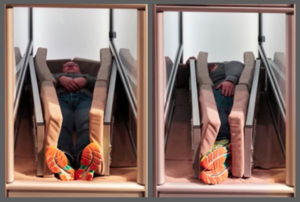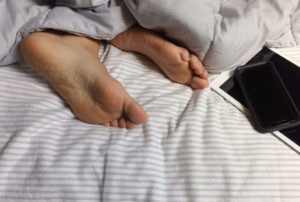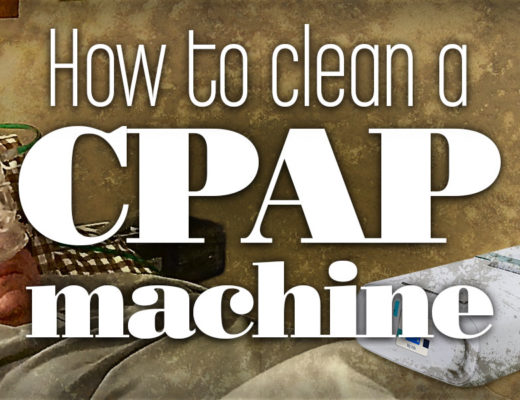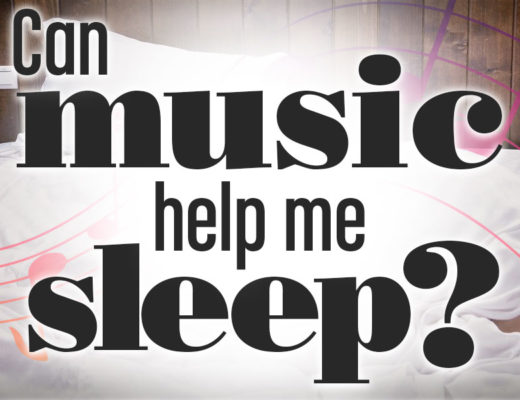“Do Weighted Blankets Help You Sleep? Do They Work For Anxiety And Other Conditions?”
Weighted blankets have become something of a craze recently, with countless companies selling their own take on the popular bedding. If you haven’t bought one yourself, odds are good that one of your friends or family members has and can’t stop raving about it. Whenever the praises of weighted blankets are sung amazing health claims are usually included. Devotees swear that the blankets will help restless sleepers stop fidgeting, curb anxiety and stress, crush insomnia, and conquer other a slew of other issues.
But what are the benefits of sleeping with a weighted blanket, and are the oft-cited claims real? Nay-Sayers may be surprised to learn that science does, in fact, support many of the health benefits associated with the use of weighted blankets. In fact, it’s not uncommon for therapists and other medical practitioners to recommend them to patients. If you’d like to learn more about weighted blankets and some of their amazing uses, keep reading below!
What Is A Weighted Blanket?
So you have a loose idea of what a weighted blanket is already. But it’s only when you learn the specifics of how they are made that you can really understand how they achieve their effects. They are, quite obviously, heavy blankets, much heavier than the standard blankets you’re already using. Despite this, they are usually designed to look like regular blankets. And on the first look will look like a nice snugly quilt. It’s only when you touch it that the differences become clear.
Weighted blankets use special fillers to gain their heft. The most common is polypropylene or plastic pellets, but sometimes other materials are used. Whatever the filler may be, it’s placed throughout the blanket within a series of pouches or packets. The goal of achieving equal weight distribution across the entirety of the blanket. Weighted blankets come in different weights and sizes. In order, to achieve maximum effectiveness you’ll want one that weighs 10-15% of your own body weight.
The size of the blanket is just as important as its weight. Since it works through gravity, a weighted blanket that drapes over the edge of your bed could easily slide off and find itself on the floor. It may look strange at first, but they need to be bought to fit the user, not the user’s bed.
But What Do They Actually Do?
So you might be thinking, “How does a heavy blanket actually help?” Fair question! After all, don’t we already feel secure in our warmest, fuzziest blankets, or wrapped up in our favorite quilts? What can a weighted blanket do that’s any different?
 Deep touch pressure therapy (or deep touch pressure stimulation) is the application of surface pressure similar to a heavy touching sensation, like that of a hug or a massage (and is, in fact, one of the principles of massage therapy itself). The sensation caused by this triggers the body to release serotonin and dopamine while increasing endorphin levels. On top of this, deep touch pressure therapy also lowers anxiety as well as heart rate. In short, it makes you feel happy and relaxed.
Deep touch pressure therapy (or deep touch pressure stimulation) is the application of surface pressure similar to a heavy touching sensation, like that of a hug or a massage (and is, in fact, one of the principles of massage therapy itself). The sensation caused by this triggers the body to release serotonin and dopamine while increasing endorphin levels. On top of this, deep touch pressure therapy also lowers anxiety as well as heart rate. In short, it makes you feel happy and relaxed.
Weighted blankets are able to achieve this through their added weight paired with how that weight is evenly distributed across your body. Despite their name they aren’t totally restricting, and are made so that they remain soft and comfortable on the outside. It’s not unlike sleeping under several blankets at once.
The benefits of using weighted blankets have been recognized for some time now, especially in various areas of therapy. In the United States, they’re regularly used in hospitals for their benefits, so even if you don’t own a weighted blanket odds are good that you’ve used one in the past.
How Can Weighted Blankets Help Me? And How Can I Get One?
Weighted blankets are available from any number of retailers; despite their medical uses, they aren’t a specialty item and don’t require a doctor’s recommendation in order to get one. You can find sellers online who deal only in weighted blankets (sometimes under different names, like gravity blankets or sensory blankets), and you can find them in higher-end brick and mortar stores. Prices vary but tend to be above one-hundred and fifty dollars due to all the materials used to make them. What materials are used can also have a huge impact on the price (more on that later).
As for what weighted blankets help treat, that’s a pretty big question. The range of issues weighted blankets can address is surprisingly large and diverse. This wide utility is what boosted their popularity, but as more people became attracted to the benefits of weighted blankets some started attributing positive effects to them that simply don’t exist or haven’t been proven. This article will focus solely on those that are backed by science.
Autism and Sensory Disorders
The autism spectrum is something many people find difficult to understand, especially if they haven’t directly interacted with someone who is on the spectrum. The elements that are commonly recognized are repetitive behaviors and poor or awkward socialization but sometimes overlooked over-stimulation to physical stimuli. Something like a texture or a firm touch can sometimes be enough to trigger panic in someone with autism.
 Weighted blankets originated as an improved, simplified version of the squeeze machine (sometimes called a hug machine or squeeze machine), a therapy tool used by people on the autism spectrum. The machine applies pressure across the body similar to a hug, releasing the chemical oxytocin in the brain and calming the user down while making them feel more secure.
Weighted blankets originated as an improved, simplified version of the squeeze machine (sometimes called a hug machine or squeeze machine), a therapy tool used by people on the autism spectrum. The machine applies pressure across the body similar to a hug, releasing the chemical oxytocin in the brain and calming the user down while making them feel more secure.
This was developed by Dr. Temple Grandin, who herself is on the autism spectrum. Since its creation, the machine and variations of it have been very popular with autism research and therapy, but the machines themselves are usually very expensive, putting them out of reach for some. Weighted blankets were designed to apply the same ideas to a much less expensive, more widely available product.
Autism is one of many sensory processing disorders. Simply described, sensory processing disorders send signals to the brain that greatly distort the sensation of physical touch. Whereas a hug would normally make one feel warm, safe, and happy, a sensory disorder would cause those feelings to be distorted into anxiety, fear, and discomfort. Weighted blankets counter this by applying pressure that’s not too firm and not too light, creating the same sensation of being squeezed by someone without the tactile discomfort that brings.
Difficulties
Some of the difficulties that those on the autism spectrum have with social interaction (including physical interaction) are that they aren’t in control of other people or how their actions impact their hypersensitivity. Stimulation that lasts too long can cause great distress. Researchers believe weighted blankets, like the squeeze machine, are so effective because as objects they can be manipulated by the user to find just the right balance.
In addition to being hypersensitive to certain textures and pressure, an autistic may also seek out certain pressure and textures for their comfort. Weighted blankets, being adjustable by design or simple manipulation, are an easy way for someone to achieve this. They can be used to cover only certain areas of the body, or with some makes can have their weight reduced or increased for less or more pressure. The end result is a deeply calming, relaxing effect.
It should be noted, however, that autism encompasses a large number of symptoms, and symptoms can vary from person to person. Weighted blankets do not treat every symptom, just what has been described above. Some people write about weighted blankets being a total treatment of autism, but that’s sadly not true. This idea likely stems from a misunderstanding of how weighted blankets work, the range of symptoms on the autism spectrum, or both.
Insomnia
It’s not exactly a secret that America has an ongoing sleep crisis. The vast majority of us simply aren’t getting enough sleep and suffer physically and mentally as a result. While many factors contribute to our ongoing sleep issues (poor sleep hygiene and practices being chief among them), many have complex chemical balances that lead to insomnia. Sometimes, a simple change of habits isn’t enough to conquer insomnia.
Insomnia is defined as difficulty falling asleep and/or staying in a sleep state. Those with insomnia have great difficulty falling asleep, even late in the night, and because of this they struggle with low energy during the day and suffer from poor concentration. Insomnia slowly impacts other areas of life as it continues, and in the long term can create very serious physical and mental health issues. There are two recognized types of insomnia.
Acute insomnia
Acute insomnia is usually the result of circumstances in one’s life, like stress or anxiety, and will eventually pass as those circumstances do. This type of insomnia is very common, so much so that most people don’t even recognize it as insomnia (“It wasn’t insomnia, it was just anxiety!”). Other external factors that can lead to acute insomnia include visual stimulation close to bedtime (such as computer monitors and television) and diet (such as consumption of caffeine). In these instances, changes to one’s habits or environment can effectively treat acute insomnia.
Chronic insomnia
 Chronic insomnia is much more complex than its acute counterpart. As its name suggests, chronic insomnia is ongoing, generally defined as lasting longer than three months and occurring three nights out of the week. The condition can be caused by some of the same things as acute insomnia, but also include side effects of medication or other medical conditions. There’s still a great deal about chronic insomnia that remains unknown, however, and other causes may exist on top of these.
Chronic insomnia is much more complex than its acute counterpart. As its name suggests, chronic insomnia is ongoing, generally defined as lasting longer than three months and occurring three nights out of the week. The condition can be caused by some of the same things as acute insomnia, but also include side effects of medication or other medical conditions. There’s still a great deal about chronic insomnia that remains unknown, however, and other causes may exist on top of these.
One of the benefits of deep touch pressure therapy is that it promotes the release of more serotonin in your body. With more serotonin comes better mood regulation and a heightened sense of calm, and lowering the activity of the central nervous system. Before bedtime, benefits all coming to make falling asleep naturally a much easier experience.
But serotonin continues its work by helping to produce melatonin. Melatonin helps the body regulate sleep, which includes establishing a regular schedule for sleep. You’ve probably seen it sold in pill form at your local pharmacy. Higher levels of melatonin results in regular, deeper sleep.
If you’ve been diagnosed with insomnia or suspect you may have it, a weighted blanket can be used in the long term or short term to get you back to a night of healthy, meaningful sleep.
Restless Leg Syndrome
 People sometimes think restless leg syndrome (also known as RLS) is just a general restlessness paired with fidgeting, but it goes well beyond that. The neurological condition causes incredible pain in the legs that only ease with movement. Its persistence makes it incredibly difficult to fall asleep, and worse yet, RLS only occurs at night, following the sufferer’s circadian rhythm.
People sometimes think restless leg syndrome (also known as RLS) is just a general restlessness paired with fidgeting, but it goes well beyond that. The neurological condition causes incredible pain in the legs that only ease with movement. Its persistence makes it incredibly difficult to fall asleep, and worse yet, RLS only occurs at night, following the sufferer’s circadian rhythm.
Despite the name, RLS can occur in other parts of the body, including the arms, head, or chest. The painful sensation experienced has been described differently by patients, ranging from simple pains to the more bizarre, like throbbing or crawling. Movements dispel these feelings, but not for long, and soon a night of rest becomes one of frustration and exhaustion. Over time, something called periodic limb movements of sleep (PLMS) develops, where the sufferer has spasms all throughout the night, sometimes every minute.
You won’t be surprised to learn the RLS can cause some of the same health risks as insomnia, and indeed, can even be a gateway to insomnia. Ultimately, its causes are unknown, though several different causes have been suggested. Doctors will generally recommend a combination of medications and physical therapy to minimize the effects of RLS.
The benefit of weighted blankets for those suffering from RLS is twofold. First, the extra weight makes restrains unintentional movement somewhat, so if you experience PLMS the frequent spasms can be reduced through the additional pressure. Second, as explained previously, the extra melatonin promotes regular sleep. Besides causing sleeplessness, the symptoms of RLS are further fueled by sleeplessness; it’s an engine that powers itself.
Weighted blankets are not an all-or-nothing fix for RLS, but rather should be considered as part of a greater treatment plan.
ADHD
 Like autism, ADHD (and ADD) have a long history of being misunderstood, made all the more confusing by categorizations of the disorders themselves. For this article, we’ll be using ADHD (Attention Deficit Hyperactivity Disorder) to describe both itself as well as ADD (Attention Deficit Disorder) for the sake of simplicity, but we are talking about both.
Like autism, ADHD (and ADD) have a long history of being misunderstood, made all the more confusing by categorizations of the disorders themselves. For this article, we’ll be using ADHD (Attention Deficit Hyperactivity Disorder) to describe both itself as well as ADD (Attention Deficit Disorder) for the sake of simplicity, but we are talking about both.
It used to be that whenever someone thought of ADHD, they would seemingly focus on the hyperactivity part and disregard the rest. The mistaken solution they often came to was trying to force whoever had ADHD to calm down, as though it were a simple choice. But for adults and children who ADHD makes something that seems so easy incredibly difficult, fueling frustration that inevitably bursts out in other ways.
Traits of ADHD
Though hyperactivity and an inability to stay still are among the most common traits of ADHD, others shouldn’t be ignored. One is the ability to focus on something for long periods of time, though this isn’t complete inability to focus (as was previously believed). The second is much more subtle but can be just as distressing. It is, in essence, an intense amplification of emotions: soaring highs and crashing lows.
ADHD, though widely discussed for years, wasn’t really understood until fairly recently. We now know it isn’t a behavioral disorder is a developmental impairment. What this means is that medication alone is a weak approach to managing symptoms and that someone living with ADHD really needs to consider lifestyle changes if they want to overcome the challenges they face in their daily routine.
Deep pressure touch stimulation soothes the activity of the central nervous system. It brings about a calm that helps alleviate extreme moods and sensitivity brought about by ADHD. Parents have reported success in training their ADHD children to seek out and use their blankets when they feel overwhelmed. They said that it brings them back down (or up) from whatever they were experiencing at the time. The same effects are achieved at night to curb and prevent the effects of a racing mind.
Use of weighted blankets for ADHD initially stemmed from its success in autism therapy. Though the disorders are unique from one another. It’s no surprise that their overlapping symptoms can be treated with weighted blankets.
Post-Traumatic Stress Disorder
 Though Post-Traumatic Stress Disorder (also known as PTSD) is most commonly associated with soldiers, it can develop in anyone who has experienced a very frightening or dangerous situation. For example, victims and witnesses of violent crimes commonly develop PTSD themselves. The symptoms of the disorder are far-reaching, including insomnia, recurring nightmares, panic attacks, low and depressive moods, and a feeling of always needing to be on high alert.
Though Post-Traumatic Stress Disorder (also known as PTSD) is most commonly associated with soldiers, it can develop in anyone who has experienced a very frightening or dangerous situation. For example, victims and witnesses of violent crimes commonly develop PTSD themselves. The symptoms of the disorder are far-reaching, including insomnia, recurring nightmares, panic attacks, low and depressive moods, and a feeling of always needing to be on high alert.
These symptoms overtime come to dominate all areas of one’s life, severely limiting what they feel they can do and how they can interact with other people. When someone suffering from PTSD is in a situation that triggers their symptoms, they can continue to worsen until the can remove themselves from it. The heightened “fight or flight” impulse can lead to intense outbursts if the person can’t remove themselves from the situation or otherwise feels trapped. Essentially, the symptoms make them feel as though they are back in that situation that caused their PTSD in the first place.
The deep pressure touch stimulation effects of a weighted blanket cause the body to increase the production of serotonin and dopamine. These two hormones relax the central nervous system, with the rest of the body following suit. This is particularly useful when trying to sleep, as people with PTSD often wake-up suddenly and have difficulty falling back asleep.
Anxiety
 Everyone has experienced anxiety at some point in their lives, that heightened sense of fear that causes your heart to race, your breathing to become rapid, and your thoughts to go in every direction at once. It can be a natural occurrence or you could be diagnosed with an anxiety disorder. But the feeling is (for the most part) the same. And when it occurs at night at wreaks absolute havoc on even the healthiest sleep cycles. When unchecked, anxiety (and anxiety orders in particular) can dominate one’s life to the point where they feel comfortable in situations and places where they once did.
Everyone has experienced anxiety at some point in their lives, that heightened sense of fear that causes your heart to race, your breathing to become rapid, and your thoughts to go in every direction at once. It can be a natural occurrence or you could be diagnosed with an anxiety disorder. But the feeling is (for the most part) the same. And when it occurs at night at wreaks absolute havoc on even the healthiest sleep cycles. When unchecked, anxiety (and anxiety orders in particular) can dominate one’s life to the point where they feel comfortable in situations and places where they once did.
Anxiety as a disorder can be treated with medicine and in any form can be helped with coping strategies; like deep breathing. For disorders patients will usually have both. Using medication on a regular schedule and using coping mechanisms as they recognize their symptoms flaring up. Anxiety as a mental illness is naturally linked to and often occurs alongside depression and other mood disorders.
The melatonin production resulting from the serotonin production triggered by deep pressure touch stimulation may help with the symptoms of anxiety. “May” is used here because, unlike other examples here, not many studies have been conducted regarding the effects of a weighted blanket on anxiety. A majority of participants in the few that have taken place reported that they felt the blanket eased their symptoms. And researchers found participants slept for longer. While there isn’t a general consensus among the medical community yet; some doctors do recommend weighted blankets as anxiety coping strategies.
Fibromyalgia
 Even by the standards of chronic physical conditions, fibromyalgia can be devastating. Those living with it feel pain throughout their body, sometimes localized in specific areas and sometimes scattered throughout. At the same time, the central nervous system amplifies the pain. Making it more intense can causing it to last for abnormally long periods of time. At present, there is no cure for fibromyalgia, just management of symptoms.
Even by the standards of chronic physical conditions, fibromyalgia can be devastating. Those living with it feel pain throughout their body, sometimes localized in specific areas and sometimes scattered throughout. At the same time, the central nervous system amplifies the pain. Making it more intense can causing it to last for abnormally long periods of time. At present, there is no cure for fibromyalgia, just management of symptoms.
What makes the condition difficult is that it can lie dormant for a period of time before flaring up again. Periods of attack can be brief or last for days. And they aren’t synced to any anything in particular, though stress trigger symptoms. It’s impossible to plan your life around it as a result; when it strikes, there’s nothing you can do but cope with the pain until it subsides.
A weighted blanket can help with the pain of fibromyalgia through its applied pressure. Similar to how it reduces the sensory overload associated with autism. The additional weight is applied to points that cause the body to release hormones; one of which is dopamine and helps create a feeling of pleasure, numbing the pain. Users will sleep much easier at night without the pain of their attacks preventing them from dozing off or shocking them awake.
Talk To A Professional First
If you’re looking to add a weighted blanket to you treatment strategy related to any of the above conditions; check in with your healthcare provider first. It’s not very likely that they’d advise against it (there’s no real danger with using a weighted blanket). But you should always keep them in the loop of what you’re doing with your personal care. Plus, they may take an interest and want to chart the improvements you have while using a weighted blanket; your progress could convince them to recommend the treatment to other patients.
It’s important to understand that none of the conditions and disorders listed above are cured by using a weighted blanket. It’s simply a tool that can help alleviate symptoms, sometimes greatly. A weighted blanket also shouldn’t be used in place of any prescribed medications, devices, or coping strategies recommended by a healthcare practitioner. Just consider it another tool at your disposal.
Are There Really No Risks?
That’s right! Weighted blankets are completely safe for adults and children. They can become quite warm and make the user overheat, especially if used in hotter months. But short of having a bad reaction to the materials, it’s made of that’s the only issue you’ll encounter.
However, it needs to stated that weighted blankets are absolutely NOT for infants. A weighted blanket poses a serious risk of injury or Sudden Infant Death Syndrome to babies and infants; even if it is sized for them. Always follow the manufacturer’s age guidelines and don’t risk it!
Why Does My Weighted Blanket Make Me Feel Uncomfortable?
If you’ve never used one before, you might find your first night sleeping with a weighted blanket a bit uncomfortable. Even if you’re still getting some benefit from it, it’s understandable that you’d want to fix this problem and get as comfortable as possible. To that end, here are a few tips to help you out:
Check the Weight
The ideal weight from your blanket should be anywhere between 10% and 15% of your own body weight. If you’ve bought a blanket that’s too heavy, the extra weight could be applying too much pressure or retaining more heat than you’d like. Some manufacturers make blankets with adjustable weight or removable exteriors, which can help lighten the load. If you still find yourself uncomfortable after that, you may need a lighter blanket.
Check the Materials
All fabrics have different levels of breathability, which helps them retain and regulate heat. One of the more common difficulties first-time users report is being too warm. A lot of this can be traced back to the fabric used in the exterior. Read user reviews online and research which fabrics work best to keep you cool.
Take a moment to inspect the filling contents, too. The actual filler used isn’t what you’re inspecting, but rather how tightly they are packed together. Most manufacturers use beads and sew them into packets spaced throughout the blanket to achieve equal weight distribution. If you find the sensation of the filler shifting towards your sides and not evenly covering you; you may want to try something that’s denser. For example, some blankets use sand instead of beads since the beads can easily shift to either side. This will upset the sense of weight distribution you’re looking for.
Do Weighted Blankets Treat Other Medical Issues?
It’s not uncommon for people to attribute other benefits to weighted blankets. You may have seen some in customer reviews or even advertised by the manufacturer themselves. However, what’s listed here are the only ones that are widely recognized by the medical community. Also, they have a scientific argument supporting them. That isn’t to say that other benefits don’t exist, or that other claims can’t be true. But you should be wary of any promises.
But if they aren’t supported by doctors, where do the claims come from? In the case of customer reviews, it could simply be the Placebo Effect—in essence; the mind tricking itself into thinking something is true. This has been long documented in the psychology community. Likewise, it could be a simple coincidence.
It becomes a bit more complicated with manufacturers. And we obviously can’t speak to anyone’s intention in how they choose to advertise a product. But just to be safe (and to reiterate), be careful with any promises made.
Are There Any Benefits to Weighted Blankets If I Don’t Have Any Of These Conditions?
Absolutely! While the above benefits discussed so far have been framed in the context of specific conditions. That doesn’t mean weighted blankets can’t be enjoyed by everyone. The underlying function of deep pressure touch stimulation is to help the body release more hormones; that promote relaxation and happiness. That means that if you simply need a deeper sleep, weighted blankets can deliver.
They’re also quite useful for anyone who tosses and turns in their sleep. The additional weight serves to limit excess movement. It’s comfortably snug but not totally restrictive. People who used to toss and turn in their sleep have found weighted blankets a simple, effective solution.
If you’re looking to treat a specific problem, or you just want to discover a more relaxing way to sleep. Don’t be afraid to give weighted blankets a try. Science is on your side!





